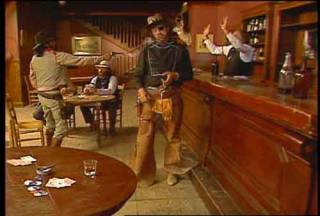Overview

Mad Dog McCree is a historical-fantasy full-motion video light-gun shooter developed and released by American Laser Games for arcades (using Amiga-based ALG hardware) in North America on December 1990. It was later released in Europe by Atari Games and in Japan by Capcom.
Set sometime in the U.S. Old West, players control a mysterious gunslinger in (and around) an old western town taken over by a gang of bandits led by the titular Mad Dog McCree. Aided by a rambling prospector (played by Ben Zeller) and several townsfolk, the "stranger" must investigate the whereabouts of Mad Dog's hideout and set out to take out his gang and rescue the mayor.
It is the first game from American Laser Games and uses LaserDisc technology to render full-motion video. Similar to to other arcade games that use LaserDisc technology (such as Dragon's Lair and Time Gal), the gameplay make use of quick-time events (which, in this game, involve shooting parts of the screen with the revolver-style light-gun at the correct place and time). As one of the earliest light-gun games of its type, it is notable for its mechanic of reloading the weapon (which involves "holstering" it by aiming downwards, away from the screen), which is also key with the game's unique "showdown" segments.
Along with the 1992 sequel and multiple successors (The Last Bounty Hunter and Fast Draw Showdown), the game received multiple computer and console ports between 1992-1994, as well as several unique ports a decade later (including one for DVD players, one for the motion-controlled Wii, one for the touch-based 3DS, a smartphone release, and a higher-definition PS3 release). Its ALG hardware was also easy to convert between the studio's later games.
The game was also included in a later revision of the 2002 Global VR PC-based arcade cabinet Six Gun Select, along with Mad Dog II: The Lost Gold, The Last Bounty Hunter, and Fast Draw Showdown.
Gameplay
As one of the earliest light-gun games of its type, players are tasked with shooting each enemy or target, one-at-a-time, at the correct time. They are scored for successful hits, and can lose a life by failing to shoot enemy gunslingers and certain targets, shooting innocent civilians, or shooting the wrong direction in certain crossroads.
Players have six shots to work with at a time, and can reload by "holstering" their light-gun (aiming downwards, away from the screen). In addition, players can shoot cow skulls and spittoons to reload with double the ammunition.
Some of the game is non-linear, allowing players to proceed through the first part of the game in any order. The game also includes some adventure-style puzzle elements, where players must proceed through the game in a specific order (i.e. requiring to get the jail keys from the saloon before freeing the sheriff from jail, or requiring the map from the mines to find the correct path to the hideout). Success in certain segments also give the player clues to progress through the game, such as a trick Mad Dog uses in his showdown.
One of the key features of the game is its "showdown" segments where, at random parts of the story, the gunslinger will be challenged to a classic duel and must keep the weapon "holstered" until it is time to draw. In certain ports, this is altered so that the weapon is unloaded, and players must reload when it's time to draw.
Ports & Re-Releases
The game later received ports for the Sega CD, CD-i, 3DO, and both MS-DOS and Windows PCs between 1992-1994. These ports vary in video quality and support not only compatible light-guns, but also controllers and mouse inputs (some of which use a separate button for reloading). It also received ports to multiple systems a decade later, all of which use higher-definition video and most of which were released by Digital Leisure:
- On November 13, 2001, it received a DVD-Video game release. Compatible with most DVD players, this version simplifies its gameplay by removing the scoring system and the random "showdowns", and having players moving the cursor in larger chunks with a standard DVD remote.
- On December 20, 2011, the game was released digitally for iOS devices. This version features touch controls, having players fire by tapping the screen and reload by tapping the ammunition counter at the bottom-left.
- On June 14, 2012, it received a digital Nintendo 3DS release, ported by Engine Software. This version uses unique touch controls, where the bottom touchscreen determines the crosshair for the main screen.
- On January 22, 2013, it received a digital PlayStation 3 release. This version features global leaderboards.
Most ports revamp the original game's UI, with their own display of the game's score, ammunition, and lives. Later ports feature new effects for weapon firing, hitting targets, and getting hit.
Log in to comment